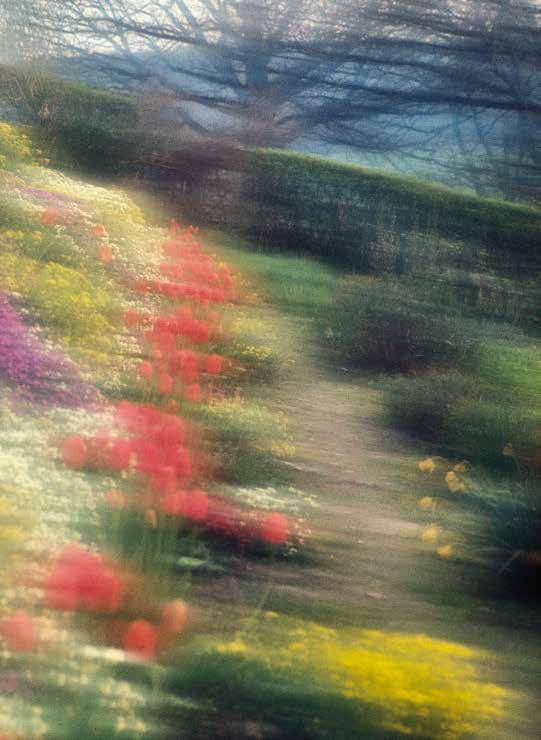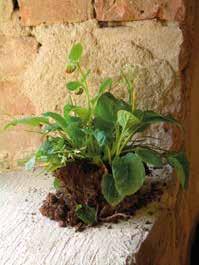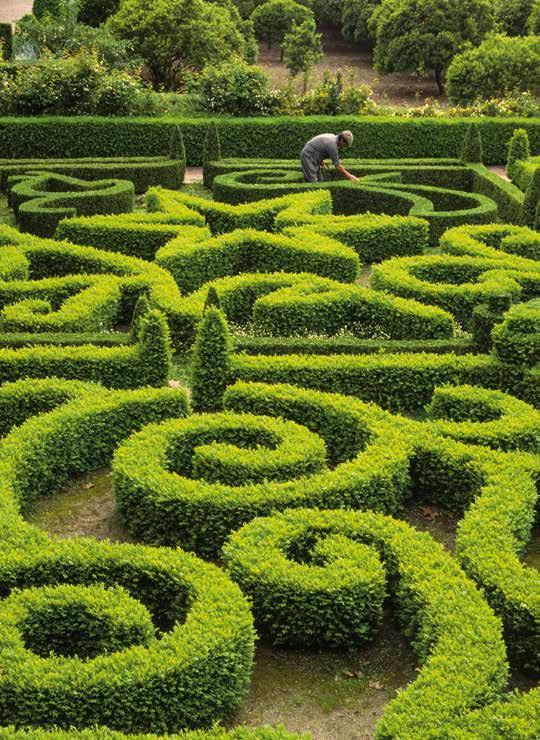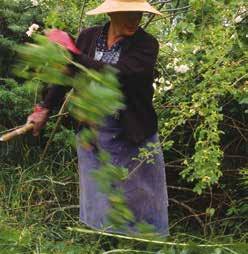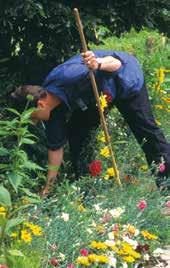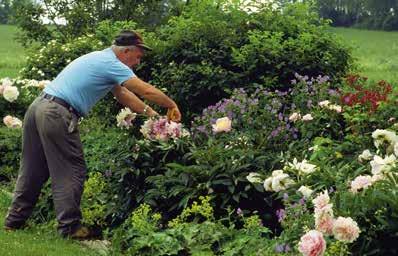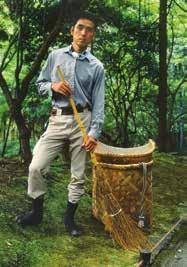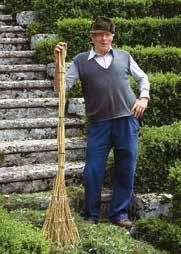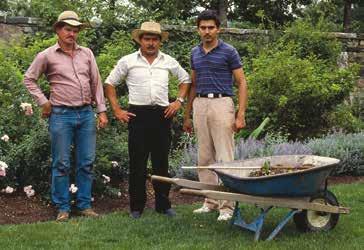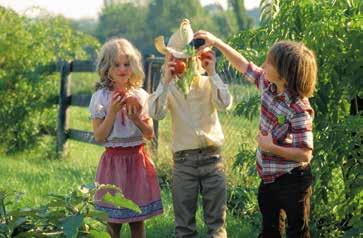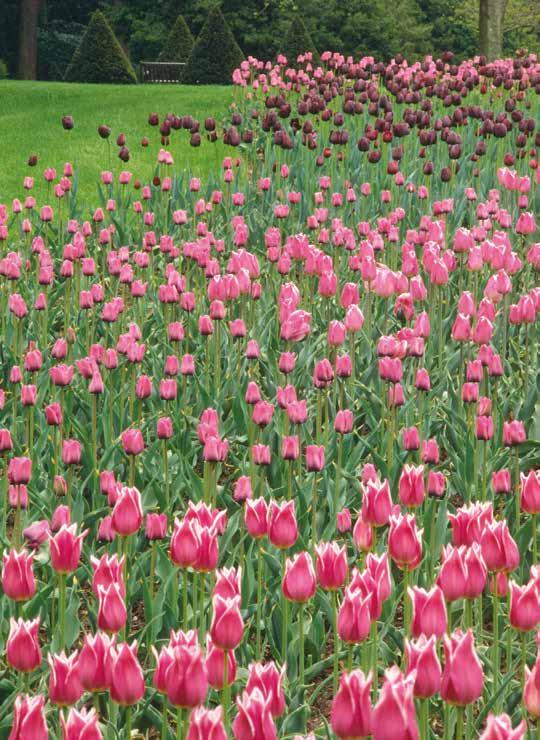Preface
p.6
White Strawberries
p.8
Weather Permitting p.22
My Good Earth p.48
The Rake’s Slow Progress p.66
The Draughtsman’s Contract p.84
Leaves of Grass and Bales of Hay p.106
The Lure of Flowers p.128
In Praise of Shrubs p.152
Timothy Hill p.180
A Thorny Issue p.200
West of Eden p.212
Mysterious H2O p.240
Notes
p.266
eludes us. I appreciate this fact as a form of freedom, at least until that is gone too, at which point we will be facing new wars and conflicts about who will direct the sky. Until then we can happily continue to vent our annoyance about the lack of precipitation, the floods, or the exaggerated heat, without aiming our discontent at anyone in particular. Every morning we will come to terms with or prepare for what awaits us outside according to our personal disposition and upbringing. The English butler, upon opening the heavy drapes, greets the guest with a breakfast tray and a
The farmer and photographer’s idea of perfect weather : light clouds mixed with sun.
The Japanese section at Brooklyn Botanical Garden in New York
“Lovely gray sky out there,” while the Italian maid emphatically exclaims “Che brutto tempo!” when she perceives two solitary clouds in an otherwise blue sky, puts down your double espresso, and suggests you might want to change your plans. But to no one is the weather of more interest than to the avid gardener. He and she grumble about it most days. It seldom is perfect. It is here at the outset that I want to stress an important point: a garden is not a natural occurrence, it is artifice. Horticulture is inclined to foster the rare, which is often synonymous with foreign. For centuries, daring explorers and plant hunters have pried or, more likely, carefully lifted botanical specimens from their native habitat and introduced them to a new location with the desire to make them grow elsewhere. Thus the plants are often put at risk; in their birthplace they seldom get sick or die young. They had millions of years to adapt themselves to freezing temperatures or severe drought or whatever conditions prevail in their place of origin and thus have become biologically programmed to survive these adversities. Not so in the garden, which you could compare to a casino: gambling is going on. This is precisely what makes gardening such an enthralling pastime. A lot of sins are committed in the backyard. Not just in botanical terms, but in esthetic respects too. Most perplexingly, I met some accomplished intellectuals who think of gardens as visually disturbing. After many years of toil and soil I can at least see what they mean although I am not ready to subscribe to their views.
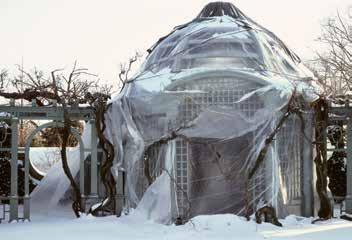
Winter protection for the gazebo is a necessity at Old Westbury Gardens on Long Island, New York.
The interim years we had spent on planting trees, to give shape and shade to the terrain surrounding the house. Some of them had found an underground vein of water and were growing faster than others. But gardening cannot be left to chance. Plenty of organic matter of any kind was needed—spent hops, peanut shells, algae, leaf mold, mushroom compost—but none of these recommendable soil improvers could be found. There were no nurseries of quality nearby. We were among farmers, whose wives had little time to grow flowers and were content with the inevitable red geraniums and a few roses. Six-packs of petunias in mixed colors and frequently mislabeled vegetable seedlings were the typical offering at local feed stores or at the weekly markets. The more distinguished nurseries were far away, in Tuscany, the cradle of everything including arborists and the nursery trade.
No matter how much organic stuff I added to my soil, nothing had a lasting impact. Whatever I did, within twelve months or so it reverted to its former churlish self, making me feel like Sisyphus himself. Despite my manifold efforts, quite a number of the small plants I bought in pots went into a rapid decline once in the ground and became smaller every week, then disappeared completely. Initially I attributed the cause to the soil being too alkaline, a condition exacerbated by the frequent lack of rain. But when no fertilizer or magic potions helped, I began to understand that the problem was not one of chemistry but of mechanics. Plants started in pots in a soft growing medium have fine roots and cannot hack it when suddenly surrounded by stiffer soil, which they are unable to penetrate. Even the proverbial one-dollar hole for a ten-cent plant did not work, because it gets the roots only so far. Finally, only when I resorted to adding sand—river sand to be sure, not builder’s sand, which would have made the catastrophe complete—did things begin to look up. Many shrubs took a leap forward, and even some smaller perennials such as the intensely blue flowered Ceratostigma plumbaginoides and the Epimedium pinnatum began to multiply and conquer new territory as they are supposed to. As did a single sprig of a silver-edged groundelder, which had literally stayed put for twelve years without ever budging. It suddenly took off with boundless enthusiasm, giving proof that the right kind of friable soil is the main road to success.
cake.
In all these toils I was never alone. Several characters kept me company in the background. First, there was Jacob from the Old Testament, with his seven-year servitude for what turned out to be the wrong bride (Katonah), and seven more for Rachel, a marriage that ended too soon (Millbrook). Later in Italy, where I wrestle with our intractable soil, Arthur Schopenhauer kicks in and whispers in my ear: “Fool that you are—did I not underline that there is no bigger misfortune than to overlook happiness when you have it at your fingertips! Why were you not content with your pH value of 6.8?” So I reconcile myself with my soil and currently find encouragement in Picasso’s remark: “What keeps me working today is the notion that tomorrow I’ll be worse.”
Pierino is optimistically looking into the future on a mountain of cow manure.
Plowing and seeding is still done the biblical way in Morocco.
The Rake’s Slow Progress
When deliberating whether it was gardening or agriculture that made its entry first into our history, I have no doubt that it was gardening: the delightful pursuit of beauty. As my imagination turns to the cool mists of time, I envision our prehistoric ancestor returning from a successful hunt and throwing his kill—a reindeer perhaps—onto a rock, content to have secured a few juicy meals, when he perceives a single, wonderful flower near the entrance to his cave. Poetic license permits me to suggest it was a poppy, maybe even a blue Himalayan poppy, that most spellbinding of flowers, breathtaking to look at and— 14,000 years later—given the name Meconopsis betonicifolia. My Homo sapiens calls out for his female companion, and they both gaze in awe at the pure sky-blue blossom. In order to see it better, they liberate it from some grasses that grow near it, and scratch around its base with a stone wedge. They relish the sight every day, and may have had some regrets when the last bloom was gone. Life went on as usual, and the following year not one flower sprang up in the same spot, but three, and a whole slew more a few steps away. It was the Golden Age of humanity. There was enough game and food around for everybody, and gathering provided just the right amount of entertainment and exercise. Nobody was obese, or even overweight, and nobody had to go to the gym. Then it all changed. God was introduced, and He in turn invented Adam and Eve, who were pushed into agriculture and the therewith connected struggles and necessities. Life became more complicated, even if seemingly securer. Suddenly there were obligations to be met, deadlines to be kept; arguments arose and accusations were batted back and forth.
What is sure is that our Stone Age forbears were sharp observers of plant and animal life and in close touch with nature at all times. They probably had blue fingers from picking bilberries. Having a “green thumb” is not a mystical gift, but a metaphor for our willingness to look at a plant and respond to its needs. The
At Quinta da Bacalhôa in Portugal
Though the sense of touch does not immediately spring to mind, plants are rich in tactile rewards. Botanical descriptions frequently contain significant references to the quality of surfaces: the backside of a leaf can yield more information than its shape. Flower petals, too, are very varied: thick and waxy or gossamer and fragile. Many have a vaguely rubbery feeling, and touching a petal is as unique a sensation as caressing a horse’s nose. Oriental poppies for example, give us a whole slue of tactile sensations: first a hairy bud, which then unfurls its crumpled silky petals like a parachute, and later releases hard, edible seeds from the mature pod. Or it yields the sticky sap that is collected for the production of opium. An impressive sequence of sundry textures from just one plant!
Fragrance ranks high, and its absence in a flower strikes me like some curse out of Greek mythology. Many gardeners make serious compromises for this voluptuous enjoyment, selecting inconspicuous but fragrant blossoms over bigger but unscented ones. White flowers in particular seem to release intense fragrances. They may be compensating for the absence of color, or is that too anthropomorphic an observation? Fascinatingly, some blossoms produce their perfume at a specific time of day, while others only do it in the dark of night. That is yet another theme around which a garden might be designed: clockwork pink.
Given these visceral attractions, it is not surprising that we yearn to grow flowers. They sometimes enter the stage through a side door in the form of a complimentary small seed packet, added by the catalog house to an order of carrots, beets, and beans. So why not try? We follow the instructions on the little envelope and some months later we burst with pride at the sight of the vividly colored zinnia we just produced. How easy this was. Few other plants offer as much color as annual flowers. And we decide to have more. The vegetable patch is often the place where we acquire our basic training. Without meaning to be condescending, it is the kindergarten stage of gardening, where we grow things from seed, learn to keep the lines straight and the beds tidy. A novel task is “thinning out,” eliminating the smaller seedlings in each row to give the larger ones the mission to proceed and mature. Democratic principles are not applicable here—we follow the blueprint of natural selection. Most vegetables, with a few exceptions, are annuals, which means that their life cycle is completed in one year with countless seeds left behind to start again after the winter is over. This they do either by themselves or under the care of the gardener, who carefully selects the larger seeds and stores them in appropriately dry conditions. For many enthusiasts, gardening continues contentedly along these lines, which allows them to perfect their skills and expand their repertory with novel varieties and heritage seeds.
For others, the initial vegetable garden turns out to be the springboard for bigger and better things: floriculture! It comes, however, with a caveat: growing flowers is labor intensive. Annuals need seeding, thinning out, and should we desire a bushier plant they have to be pinched back, unless we aim for a long-stemmed piece of perfection for use in flower arrangements or to enter into a competition. Perennials seem easier at first, deceptively so. Most taller flowers, such as peonies and delphiniums, require staking, their supports deftly concealed; this is only possible if done at the right time and not as an afterthought when they are already tall and bushy. All this takes skill, patience, and time, plus copious watering and rich dirt.
Giving in to the urge to grow flowers, we soon handle not just annuals but biennials too, hollyhocks, foxgloves, Canterbury bells, clary sage, which bloom and set seeds during their second year and then die. Maybe on account of their slower growth they are sturdier and present us with a prolonged blooming period. They also have a way of presiding over many smaller blossoming things. No wonder, since they had a whole year to prepare for their moment of splendor. All the ones I have or had are potent self-seeders too. Once we establish the first stand we are likely to encounter them somewhere else in the garden thereafter, in a place of their own choosing, possibly as far away as the roadside. Hollyhocks are even able to grow
Traditions upheld: Amish children on a visit to Longwood Gardens in Pennsylvania, U.S.A.
Concept and photography Marina Schinz
Design Giulia Biscottini
Copy editing, proofreading Nicola Morris
Production Director Sophie Kullmann
Reprographic work, printing and binding Verona Libri, Italy
© 2024 Marina Schinz and Verlag Scheidegger & Spiess AG, Zurich © for text and images: Marina Schinz
Despite best efforts, we have not been able to identify all owners of gardens shown in this book. Individuals or institutions for whom incorrect or no information is given are asked to contact the publisher with corrections that can be considered for later editions.
Verlag Scheidegger & Spiess Niederdorfstrasse 54
8001 Zürich
Switzerland
www.scheidegger-spiess.ch
Scheidegger & Spiess is being supported by the Federal Office of Culture with a general subsidy for the years 2021–2024.
All rights reserved; no part of this publication may be reproduced, stored in a retrieval system or transmitted in any form or by any means, electronic, mechanical, photocopying, recording, or otherwise, without the prior written consent of the publisher.
ISBN 978-3-03942-195-4

